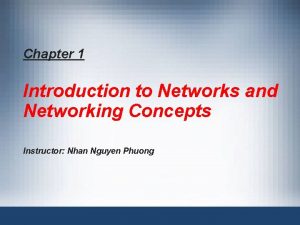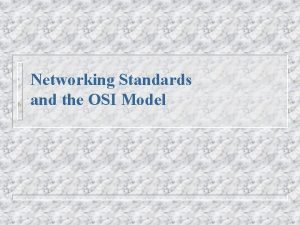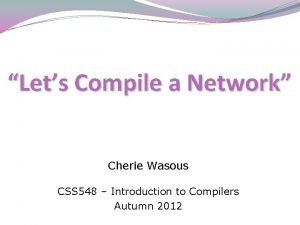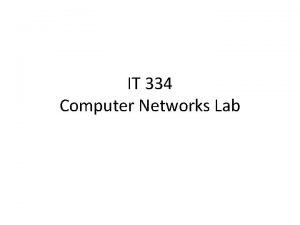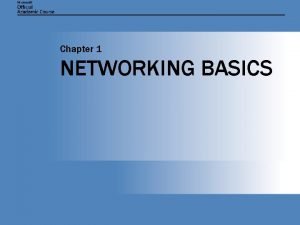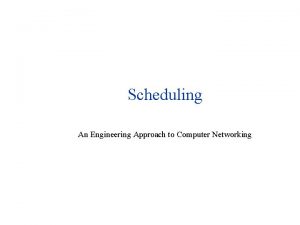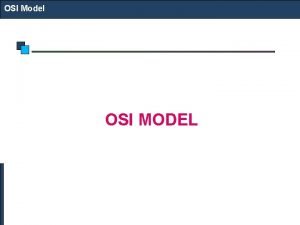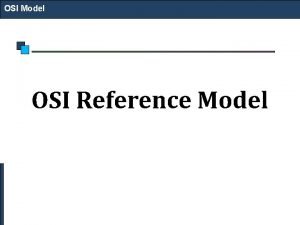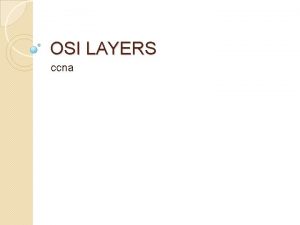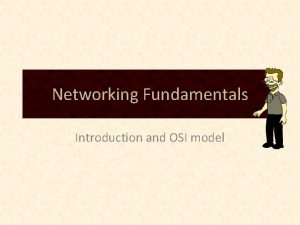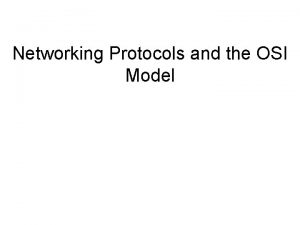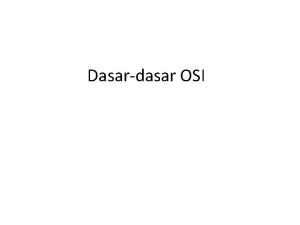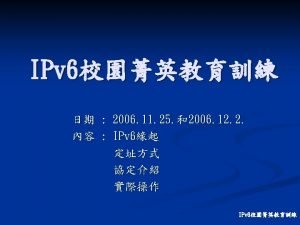Computer Networking Concepts OSI Model Introduction OSI Open











- Slides: 11

Computer Networking Concepts: OSI Model

Introduction • OSI (Open Systems Interconnect) model describes defined layers in a network operating system. Fig 1 shows OSI model. • The purpose of the layers is to provide clearly defined functions to improve internetwork connectivity between "computer" manufacturing companies. • Each layer has a standard defined input and a standard defined output.

OSI Model Fig. 1 OSI Model* *Source: http: //electricalacademia. com/computer/osi-model-layers-functions/

OSI Model Explained • This is a top-down explanation of the OSI Model, starting with the user's PC and what happens to the user's file as it passes though the different OSI Model layers. • The top-down approach was selected specifically (as opposed to starting at the Physical Layer and working up to the Application Layer) for ease of understanding of how the user's files are transformed through the layers into a bit stream for transmission on the network.

OSI Model Explained cont’d • • There are 7 Layers of the OSI model: 7. Application Layer (Top Layer) 6. Presentation Layer 5. Session Layer 4. Transport Layer 3. Network Layer 2. Data Link Layer 1. Physical Layer (Bottom Layer)

Layer 7 - Application Layer • A basic PC logical flowchart is shown in Fig. 2. The Keyboard & Application are shown as inputs to the CPU that would request access to the hard-drive. The Keyboard requests accesses to the hard-drive through user enquiries such as "DIR" commands and the Application through "File Openings" and "Saves". The CPU, through the Disk Operating System, sends/receives data from the local harddrive ("C: " in this example). Fig. 2 the logical flow chart of PC

Layer 7 - Application Layer cont’d • A PC setup as a networkstation has a software "Network Redirector" (actual name depends on the network - we will use a generic term) placed between the CPU and DOS as in Fig 3. The Network Redirector is a TSR (Terminate and Stay Resident) program which presents the network hard-drive as another local hard-drive ("G: " in this example) to the CPU. Any CPU requests are intercepted by the "Network Redirector".

Layer 7 - Application Layer Fig. 3 Simple Network Redirection cont’d

Layer 7 - Application Layer cont’d • The Network Redirector checks to see if a local drive is requested or a network drive. If a local drive is requested, the request is passed on to DOS. If a network drive is requested, the request is passed on to the network operating system (NOS). • E-Mail, client-server databases, games played over the network, print and file servers, remote logons and network management programs or any "network aware" application are aware of the network redirector and can communicate directly with other "network applications" on the network. The "Network Aware Applications" and the "Network Redirector" make up Layer 7 - the Application layer of the OSI Model as shown in Fig 4.

Layer 7 - Application Layer cont’d Fig. 4 PC Workstation with Network Aware Software

References Introduction to Data Communications Copyleft Sept. 1999 - Jan 2005 TCP/IP Tutorial and Technical Overview An IBM Redbooks publication Published 19 December 2006 Computer Networking: A Top-Down Approach (7 th Edition) James Kurose & Keith Ross
 Networking fundamentals
Networking fundamentals Sdn vs traditional network
Sdn vs traditional network Networking basics concepts
Networking basics concepts Reference of interconnection
Reference of interconnection Open innovation open science open to the world
Open innovation open science open to the world Iso networking standards
Iso networking standards Presentation layer responsibilities
Presentation layer responsibilities Open networking
Open networking Jacobson/karels algorithm
Jacobson/karels algorithm How to calculate subnet mask from ip address
How to calculate subnet mask from ip address Lan basics
Lan basics An engineering approach to computer networking
An engineering approach to computer networking


